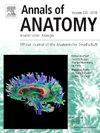The soleus muscle in comparative anatomy: Morphological variation and functional adaptation across mammals, with clinical insights
IF 2
3区 医学
Q2 ANATOMY & MORPHOLOGY
引用次数: 0
Abstract
Introduction
The soleus muscle, a deep postural component of the triceps surae complex, plays a fundamental role in human bipedal locomotion and venous return. Despite its clinical and functional importance, it remains underrepresented in comparative anatomical literature. Morphological and functional variations across species reveal crucial insights into its evolutionary and biomedical relevance.
Aim
This review aims to synthesize current knowledge on the interspecies morphological variability of the soleus muscle, emphasizing its developmental origins, adaptive transformations, clinical significance, and translational potential.
Methods
A comprehensive literature review was conducted, integrating findings from anatomical dissections, histological analyses, embryological studies, imaging data, and evolutionary biology. Representative mammalian species were compared, including humans, primates, cursorial quadrupeds, and arboreal mammals.
Results
The soleus exhibits extensive variation in morphology, fiber-type composition, and functional integration across taxa. In humans, it is hypertrophied and slow-twitch dominant, supporting upright posture and endurance gait. In contrast, the muscle is reduced or absent in cursorial species such as horses. In arboreal mammals, it retains postural function despite its small size. These differences are shaped by embryonic development, phylogenetic lineage, and biomechanical demands.
Conclusion
The soleus muscle is an evolutionarily labile but biomechanically essential structure. Its comparative anatomy provides a unique model for understanding musculoskeletal adaptation, pathology, surgical application, and bioinspired design. Future research should integrate comparative, clinical, and technological approaches to fully exploit its potential.
比较解剖学中的比目鱼肌:哺乳动物的形态变异和功能适应,具有临床意义
比目鱼肌是三头肌表面复体的深层体位组成部分,在人类两足运动和静脉回流中起着重要作用。尽管它的临床和功能的重要性,它仍然在比较解剖学文献代表性不足。跨物种的形态和功能变化揭示了其进化和生物医学相关性的重要见解。目的综述比目鱼肌的物种间形态变异,强调其发育起源、适应性转化、临床意义和转化潜力。方法综合解剖解剖、组织学分析、胚胎学研究、影像学资料和进化生物学等方面的研究成果,进行文献综述。比较了具有代表性的哺乳动物物种,包括人类、灵长类动物、爬行四足动物和树栖哺乳动物。结果比目鱼在形态、纤维类型组成和功能整合方面表现出广泛的差异。在人类中,它是肥大和缓慢抽搐的主导,支持直立姿势和耐力步态。相反,像马这样的食草动物的肌肉则减少或没有。在树栖哺乳动物中,尽管它的体积很小,但它仍然保持着姿势功能。这些差异是由胚胎发育、系统发育谱系和生物力学需求形成的。结论比目鱼肌是一种进化上不稳定但生物力学上必需的结构。它的比较解剖学为理解肌肉骨骼适应、病理、外科应用和生物启发设计提供了一个独特的模型。未来的研究应结合比较、临床和技术方法,以充分发挥其潜力。
本文章由计算机程序翻译,如有差异,请以英文原文为准。
求助全文
约1分钟内获得全文
求助全文
来源期刊

Annals of Anatomy-Anatomischer Anzeiger
医学-解剖学与形态学
CiteScore
4.40
自引率
22.70%
发文量
137
审稿时长
33 days
期刊介绍:
Annals of Anatomy publish peer reviewed original articles as well as brief review articles. The journal is open to original papers covering a link between anatomy and areas such as
•molecular biology,
•cell biology
•reproductive biology
•immunobiology
•developmental biology, neurobiology
•embryology as well as
•neuroanatomy
•neuroimmunology
•clinical anatomy
•comparative anatomy
•modern imaging techniques
•evolution, and especially also
•aging
 求助内容:
求助内容: 应助结果提醒方式:
应助结果提醒方式:


